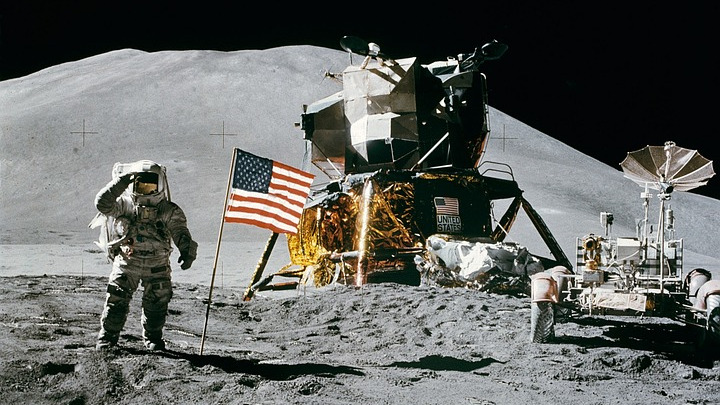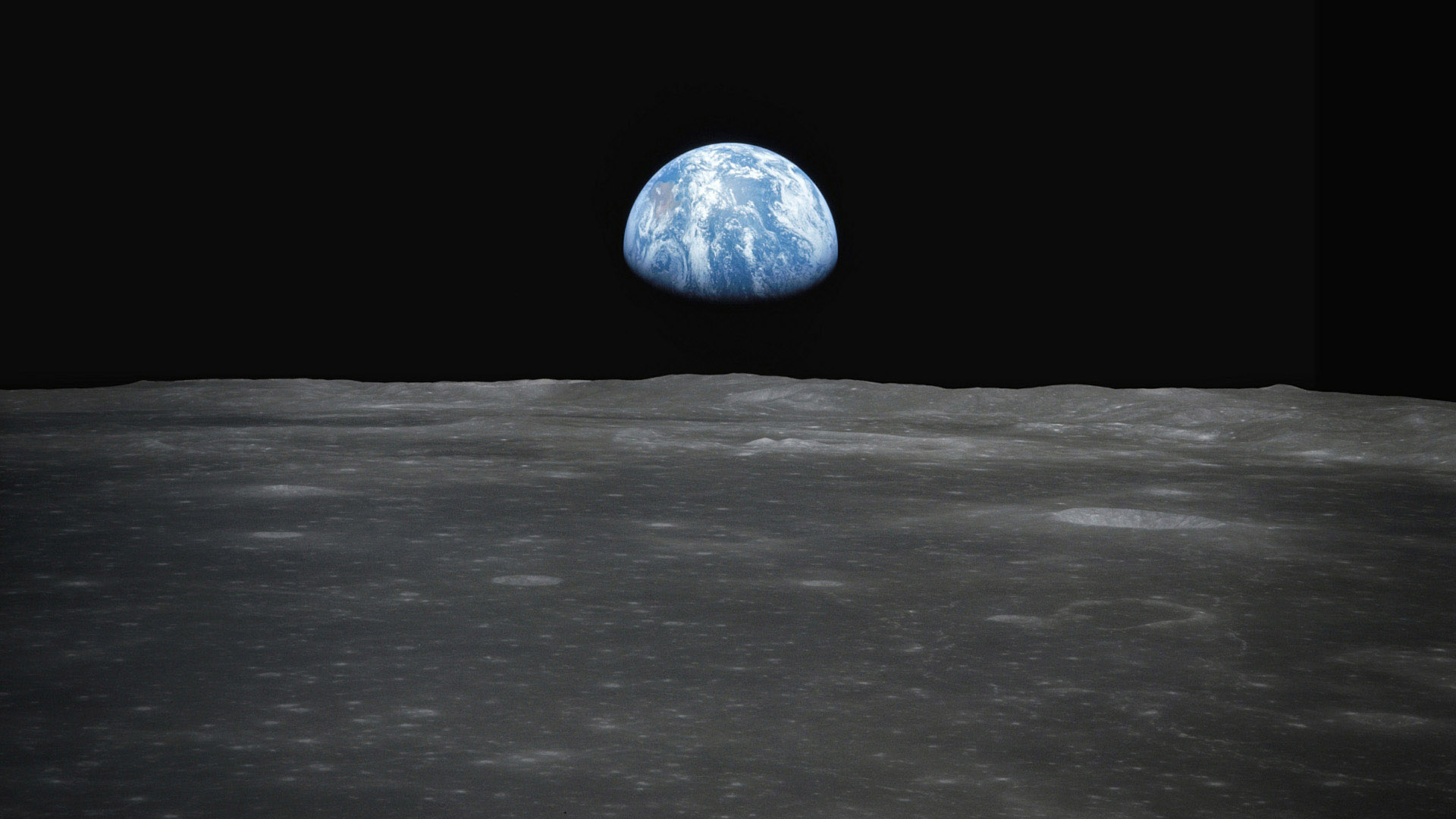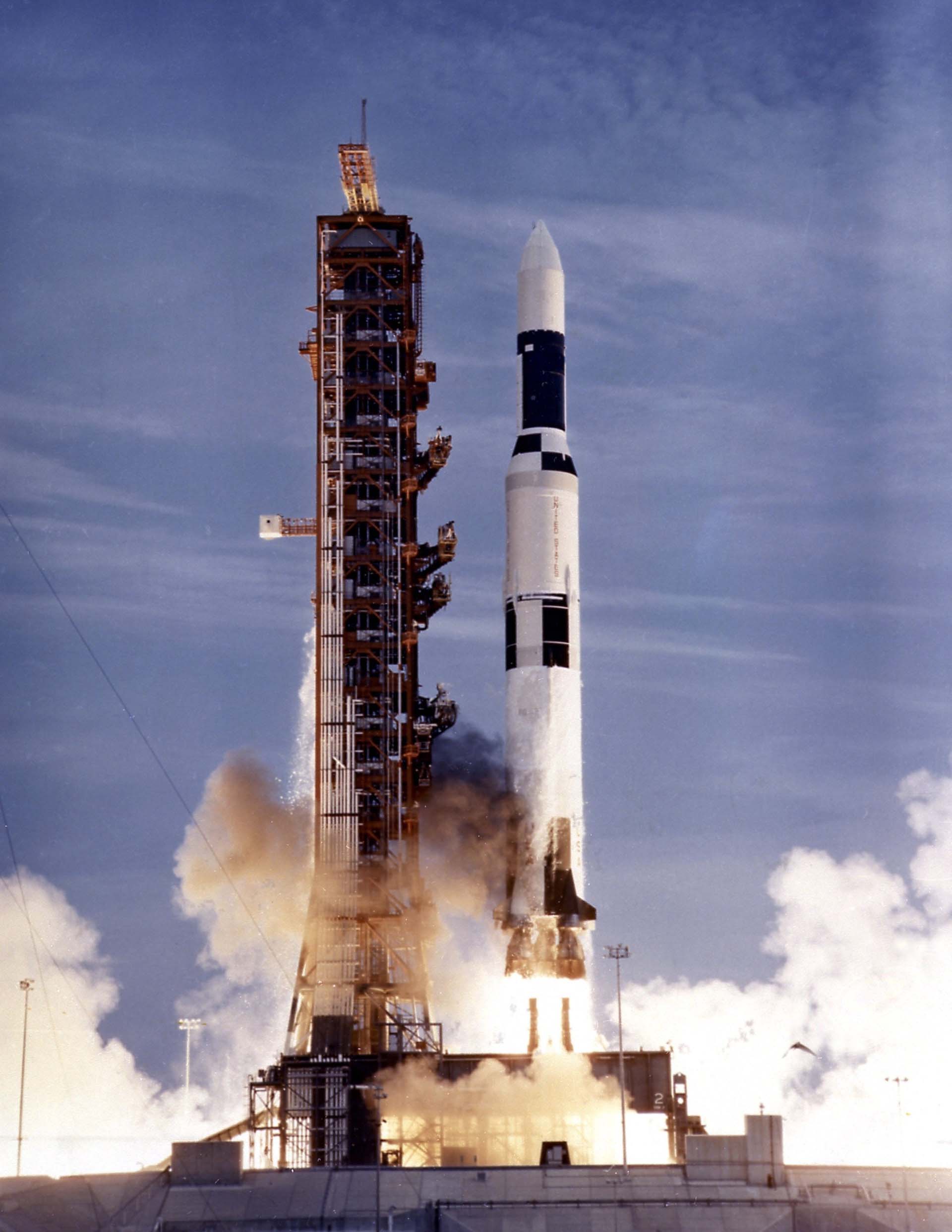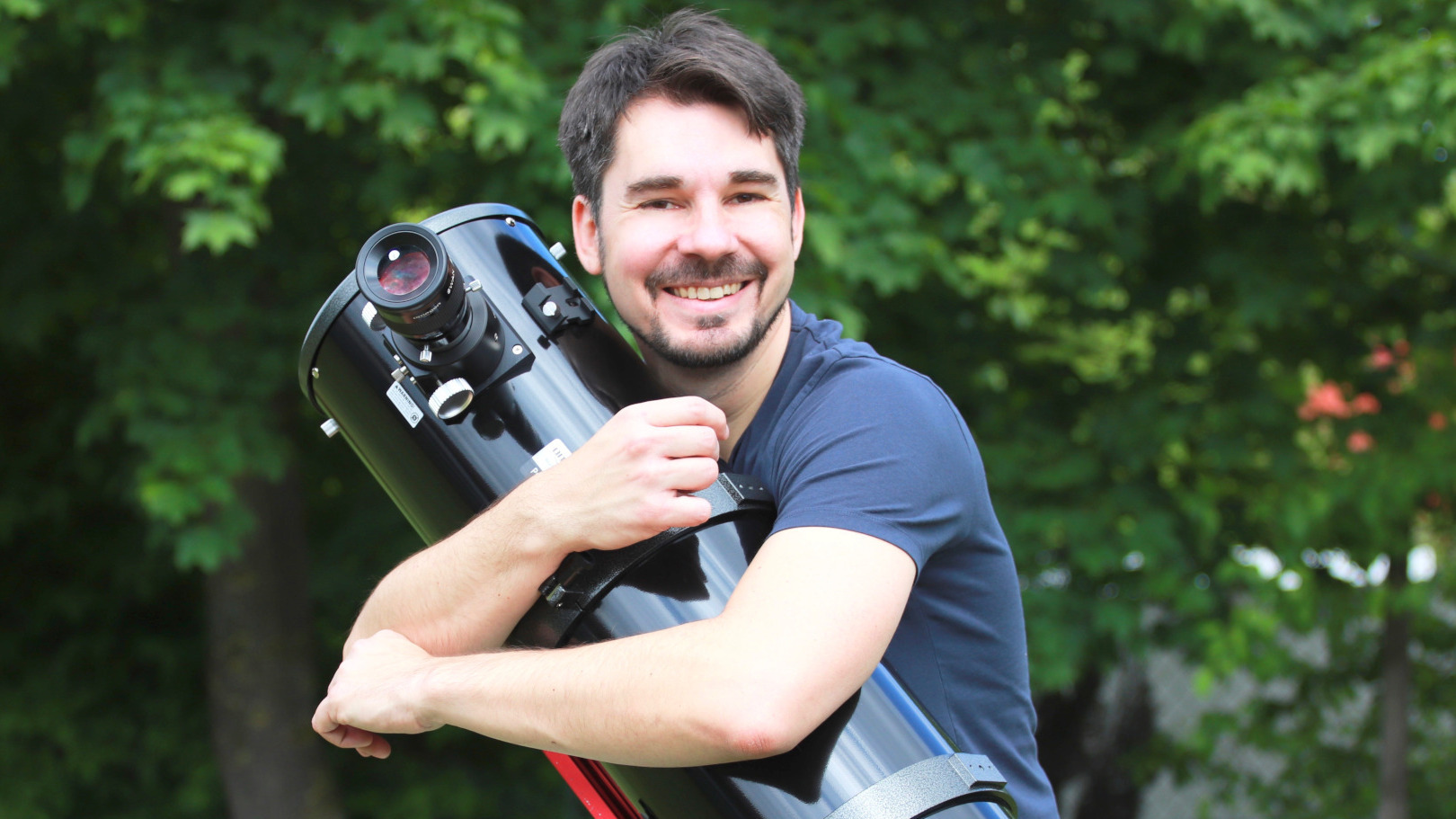Re-living the Moon Landing - 50 years after it happened
It was more than 50 years ago that the first man set foot on the Moon. But the landing almost didn’t happen. We take a look at the unique Apollo project.

Apollo 1 and the oxygen time bomb
27 January 1967.
It was just a test.
But it resulted in death, right in front of the eyes of helpless witnesses.
On that day, the enormous colossus that was the Saturn V lunar rocket soared above the launch pad. It was the largest launch tower ever built. The astronauts had taken their seats in the Apollo 1 capsule, to the rear of the Saturn V rocket. It was completely filled with fuel: three rocket stages containing 2,500 tons of liquid hydrogen and oxygen.
Then came the message over the radio:
"We’ve got a fire in the cockpit" astronaut Grissom reported from the capsule.
"Understood. Can you get out of the cockpit?" Mission Control replied.
Nothing but continual static could be heard over the radio. They had communication problems.
"Negative."
Escape was simply not possible. The capsule had become a death trap.
In what was actually a routine test, which NASA has been conducting for years, the pressure in the capsule was increased and it was pumped full of pure oxygen. A dangerous combination; and a fatal mistake.
But what had happened?
A cable had caught fire inside the rocket. A spark turned into a flame and within seconds the pure oxygen transformed the command capsule into an inferno.
The astronauts were unable to open the closed hatch due to the high pressure inside the capsule, and were burned alive. Mission Control could only listen to their screams. Then contact was lost.
The deaths of Virgil Grissom, Edward White and Roger Chaffe plunged NASA into a deep crisis. The situation at the time was one of paralysis and a state of shock.
But NASA wasn’t going to give up. In the 19 months prior to the launch of Apollo 11, they made over 100 changes to the Apollo spacecraft, certain that the mission to the Moon would be a success.
A few years earlier: the Space Race and the Cold War
In the 1960s, the Americans were determined to send an astronaut to the Moon. It was John F. Kennedy's great goal as he said:
"We're flying to the Moon," he promised. "And we’ll succeed within a decade."
Driven by the success of the Soviet Union which, on 12 April 1961, sent the first man, Yuri Gagarin, into orbit, the Americans wanted to get back on top. They had also managed to send a man into space with Alan Shepard, but their goals were bigger. Much bigger.
So they built rockets. Before they launched their lunar program they started with the Atlas rocket, which was prone to exploding at launch. There then followed Project Gemini program, the precursor to the main undertaking.
NASA gained important experience with the second manned space program and finally firmed up their plans. They advertised for astronauts for the lunar program, and hundreds applied, among them were Neil Armstrong, Michael Collins, and Buzz Aldrin. They were all test pilots at Edwards Air Force Base, located north of Los Angeles.
Apollo 8: we’re flying to the Moon
NASA had further successes with Apollo 7 and 8. After extensive modifications to the spaceship, they were ready to launch into space. Apollo 8 was the Apollo program’s second manned flight. Initially, it was planned to send the three astronauts Frank Borman, James Lovell and William Anders into orbit and to test the lunar module. However, since development work was not fully completed, it was not yet suitable for a lunar landing.
Nevertheless, due to timing, they considered venturing a flight to the Moon. But there were many reservations about this idea, and eventually common sense prevailed and the plan was dropped for safety reasons.
At the same time, NASA was preoccupied with another event: The CIA reported that the Soviet Union was also working on a manned lunar rocket, the Nositel 1. However, success with Nositel 1 would have counted as a severe setback for the USA and the Apollo program. So NASA immediately changed their plans and decided to go on a mission to the Moon after all - but without landing.
Finally everything was ready: the Saturn V rocket was launched on 21 December 1968, it flew through the Earth’s Van Allen belt, and set off for an alien celestial body for the first time in human history: the Moon.
Houston, we're on our way to the Moon.
The famous Earthrise picture was taken from Apollo 8. As the astronauts circled the Moon for the fourth time, the commander aligned the spacecraft with the Moon’s surface. They could see the surface through the side window and, as they continued to fly, a small blue globe suddenly appeared above the horizon. They excitedly grabbed their camera and captured the moment: "Oh, my God! Look at that picture over there! There’s the Earth coming up. Wow that’s pretty!" Bill Anders marvelled.
 Earthrise above the surface of the Moon
Earthrise above the surface of the MoonThe first men on the Moon: Apollo 11
There then followed the later Apollo 9 and 10 test flights. After Apollo 8, it took seven months to launch Neil Armstrong, Buzz Aldrin and Michael Collins to the Moon on Apollo 11.
The start
It was 16 July 1969, a beautiful sunny day with a blue sky. The astronauts were woken at 4am. They were taken by minibus to launch pad 39A at the Kennedy Space Center.
The three astronauts got off the bus. They were already wearing their spacesuits, dressed and ready to take off.
That Neil Armstrong was even part of the crew was lucky, because a few months earlier he narrowly escaped death in a crash in which he rescued himself from a lunar test module at the last second by using the ejector seat.
 The Saturn V rocket at the launch pad ready for lift-off
The Saturn V rocket at the launch pad ready for lift-offThe three took a service lift, which brought them up to the access hatch. Then they disappeared inside the top of the spacecraft and took their places in the command module: Armstrong on the left, Collins on the right and Aldrin in the middle.
The start was scheduled for 13:32, they were ready to go. The countdown had finished and all five engines were fired. Hundreds of people looked up excitedly from the observing platforms. The retainers detached from the rocket, releasing it. Debris dropped from the rocket and it was shrouded in smoke.
The engines rattled and the astronauts were subjected to vibrations that were so strong that they could not even press a button. People looked up in amazement with mouths open, shielding the Sun from their eyes with their hands as they watched the most incredible sight. Then the 110-metre-tall rocket slowly lifted its 2,900 ton take-off weight skywards.
The engines roared and accelerated Saturn V to 8 times the speed of sound and about 4.5G until, at an altitude of 56 kilometres, the second engine ignited and brought it into orbit 11 minutes later. They circled the Earth just once, then the third rocket stage was ignited, which brought the spaceship into a direct trajectory to the Moon.
We confirm ignition, thrust is set to “Go”. Houston, we're on our way to the Moon.
So far, many astronauts have been able to admire the Earth from orbit, but only 24 have seen it in its entirety. A round, azure-blue sphere in space that appeared so fragile to the astronauts. A small island of life in hostile space, for which we should really take much better care. Economic growth and the prosperity of selected groups of people seems to be more important than polluted oceans and the future of our children.
The dramatic first Moon landing on 20 July 1969
The flight was uneventful.
Three days after the launch, the spacecraft was approaching the Moon having covered 320,000 kilometres, when the crew spotted something strange through the window.
What was that?
A strange object that they could not identify was flying close to them, and seemed to be accompanying them. They aimed their telescope at it, but could not work out what it was.
They contacted Houston on the radio, but nobody there knew anything either. The SIV-B stage (the 3rd stage) of the Saturn V rocket was eliminated as the cause, because it was anyway around 10,000 kilometres behind them.
A UFO belonging to an extra-terrestrial intelligence?
We shouldn’t begin to speculate on this most unlikely of reasons, although some people do claim that. But whatever that unidentified object actually was remains unclear to this day.
On 19 July 1969, after about 76 hours flight time, Apollo 11 reached the Moon and disappeared behind it.
Radio contact with Earth was broken off, and the crew was completely on their own. They had an important task to carry out; at 17:22 Universal Time, they fired the retrorocket for five minutes, thereby entering the planned lunar orbit. After reappearing on the other side of the Moon, it was clear to Houston and the whole world that the braking manoeuvre had been a success.
The crew now had to rest and sleep for a while, because the lunar landing was planned for the next day. The spaceship had 21 sleeping pills on board in case any of the crew were to have difficulty sleeping.
After the thirteenth orbit of the Moon, they were ready: Neil Armstrong and Buzz Aldrin had taken their seats in the Lunar Module Eagle. Michael Collins remained in the Command Module Columbia and oversaw the separation of the two spacecraft. They remained connected to one other and Mission Control via radio. Then they began their descent sequence to the landing area close to Mare Tranquillitatis, the Sea of Tranquillity.
But during the approach they encountered problems.
The computer's alarm sounded: a light was flashing. Error 1202.
The computer system was overloaded and couldn’t handle the large volumes of data generated by the landing radar and the rendezvous radar (for manoeuvring two approaching spaceships) which had both been activated at the same time.
After a brief check, Mission Control reported: "You are Go to continue landing as planned." Then at 1,000 metres above the lunar surface: this time, the error 1201 alarm sounded, but Houston continued to give the green light. While the two astronauts struggled with the difficulties they were facing, the next problem awaited them.
Armstrong had lost sight of the landing approach, and the automatic system was heading them towards a crater with walls that were five kilometres high. They would not have been able to see or explore much if they had landed there. The astronaut was known for having nerves of steel, but what would he do? At the last moment he made a calculated decision.
At just 200 metres above the Moon's surface, he switched off the automatic system and took over manual control. Until now the descent had been vertical, but now they were firing the engines for a horizontal flight without instruments. Armstrong scanned the surface intensely, looking for a suitable landing site. Aldrin, meanwhile, reported that their fuel was almost depleted. He continued to update on the situation, which was becoming increasingly critical.
The fuel warning was on.
They were going to run out of fuel in just a few seconds.
But just at the very the last moment they finally set down gently on the lunar surface. This Moon landing was dangerous, but in hindsight it counted as one of the gentlest of the entire Apollo program. Here in Central Europe it was late in the evening, when the famous words came: "Houston, Tranquillity Base here, the Eagle has landed."
Six hours later, after the crew had rested, Neil Armstrong disembarked, slowly climbing backwards the ladder, and at 3:56 CET on 21 July 1969, he was the first person to set foot on the Moon and spoke the famous words:
That’s one small step for a man, one giant leap for mankind.
His astronaut colleague filmed this scene, which was broadcast live on television screens back on Earth, and was watched by around 600 million people around the world. 20 minutes later Buzz Aldrin followed and together the two men explored a huge desert of fine lunar dust and many rocks, 21.5 kilogrammes of which they brought back home with them. The two representatives of mankind conducted various experiments, took material samples, set up a laser reflector for measuring distance among other things, and uncovered a plaque on the landing module close to the ladder, which they left behind on the Moon which said:
Here men from the planet Earth first set foot upon the Moon, July 1969 A.D. We came in peace for all mankind.
In total, the Moonwalk lasted 2 hours and 31 minutes. Twenty-one hours after landing on the Moon, they started the ascent stage of the lunar module and docked with Columbia four hours later.
The crew was reunited after 28 orbits of the Moon. In all, the Apollo 11 crew travelled 386,000 kilometres. The mission lasted eight days and thirteen hours until they landed safely in the north Pacific Ocean.
The astronauts were recovered and quarantined for 17 days to be certain that they had not brought back any harmful extra-terrestrial bacteria.
Other Apollo missions 12-17
After Apollo 11, six more manned missions to the Moon took place, one of which nearly ended in disaster. Apollo 13 flew to the Moon, circling it, but could not land because there was a short circuit and a subsequent explosion in the oxygen tank.
The oxygen gauge rose and fell, and when the crew looked out of the window, they could see gas flowing out. It turned out that this was their oxygen stores.
They only had power in the command module for 15 minutes and, with Houston’s support, then had to convert the lunar landing module into a control module.
This made a Moon landing impossible, but at least it opened up the possibility for them to return to Earth alive. However, this was not an automatic process and they had to manually steer their own course home from the Moon.
The crew was asked to head towards Earth which they could see through the space ship window, and hold a course towards our planet’s twilight zone, which was not easy as the module swung back and forth after ignition. Thank God, the astronauts managed to return to Earth safely. Although more lunar flights were originally planned, the program ended after Apollo 17.
The public lost interest and NASA devoted itself to other tasks - they had after all achieved their goal and reached the Moon.
Apollo was mankind’s first attempt to exist in outer space away from planet Earth. Had we not stopped, where would manned space travel be today?
In recent times, the desire for a return to the Moon is getting ever stronger. Since 2019, NASA has been working on a 10-year plan for a regular mission to the Moon. And the private space company Space X also wants to fly to the Moon with Starship, its reusable spacecraft.
It is supposed to take the first tourists to the Moon in 2023 - at least that’s the plan. Will that really happen? Who knows? Are we actually ready for it? Only one thing is certain: we will return to the Moon. It’s only the question of when that is still in the stars.
Author: Marcus Schenk
Marcus is a stargazer, content creator and book author. He has been helping people to find the right telescope since 2006, nowadays through his writing and his videos. His book "Mein Weg zu den Sternen für dummies Junior" advises young people, and those who are still young at heart, what they can discover in the sky.
As a coffee junkie, he would love to have his high-end espresso machine by his side under the starry sky.

